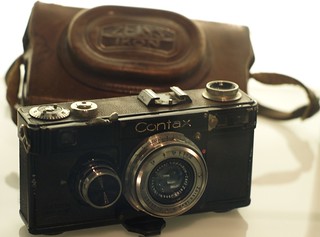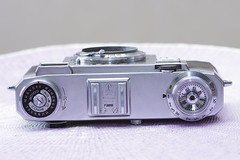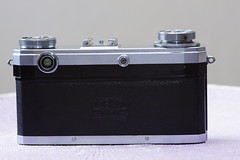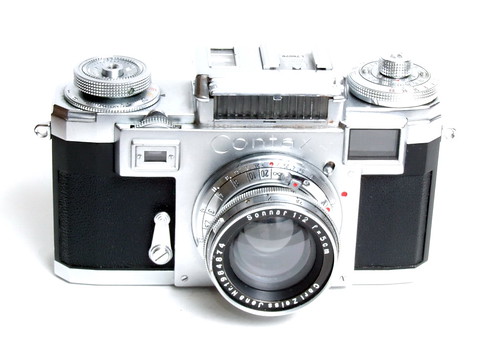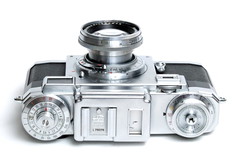Contax rangefinder
|
|
The 1930s Zeiss Ikon Contaxes
The Contax I is a high end 35mm rangefinder camera made by Zeiss Ikon to compete with Leica models. It was released in 1932. The Super Nettel was based on the Contax I, with the same kind of shutter, but a folding body, a fixed lens and a short based rangefinder. It was intended to be a cheaper alternative.
The Contax I was Zeiss' answer to Leica's offerings in the 35mm market, one Leica effectively controlled since it helped create it in 1925. It could be argued that it is technically superior to the Leica, but let down by being rushed to the market, Zeiss being eager to catch up. The Contax has a number of technological advantages over the Leica. It has a longer rangefinder triangulation base for better focusing. It has a bayonet lens mount (see Contax rangefinder lenses) instead of Leica's screw mount. It also has a removable back for loading film instead of Leica's bottom-loading system. To go up against Leica's horizontal-travel fabric shutter (maximum speed 1/500 second), the Contax has a vertical-travel articulated metal shutter (max. speed 1/1000); this is less vulnerable to sun burn as well.
However, the Contax I lacks in fit-and-finish: it is heavy and boxy with sharp corners, and suffers from many reliability problems.

|
| Contax II image by phollectormo (Image rights) |
From its introduction in 1932 to 1936 when the Contax II was introduced, the Contax I was a work in progress. There are no fewer than six iterations based on external features only. This is actually an underestimate. There were also many non-visible internal changes such as the location and physical layout of how the angular displacement of the lens couples to the rangefinder system. Other changes were meant to make the rangefinder system stay within specifications better. Later versions actually provide better focusing feedback to the user. These were not small changes, and many of the still-working models are actually later revisions. These revisions were incorporated in the Contax II, a much more reliable camera that went through fewer versions.
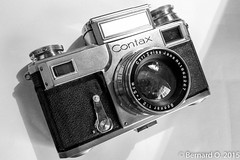
|
| Contax III (1936) image by Bernard O. (Image rights) |
The Contax II was released in 1936 and was the successor of the Contax I. It was the first camera with a rangefinder and viewfinder combined in a single window. Its chief designer was Hubert Nerwin. The Nettax was meant to be a cheaper alternative, it was a derivative of the Super Nettel with a rigid body and interchangeable lenses with a specific bayonet and a very limited range of lenses.
The Contaflex was a derivative of the Contax I. It is a 35mm twin-lens reflex with the same kind of shutter and a built-in exposure meter. It was an extremely expensive camera, that tested some of the features that would later appear on the Contax II and III. It has interchangeable lenses with a specific lens mount.
The Contax III, also released in 1936, is a Contax II with an exposure meter. It was one of the first cameras with a built-in exposure meter.
Ukrainian relaunch as Kiev-2 by Arsenal
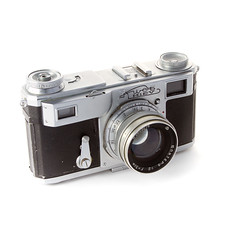
|
| Kiev image by Dima Tsvetkov (Image rights) |
After the war, the Soviet Union captured the tooling and drawings of the Contax as war booty, and transferred them to the city of Kiev, where they began the production of the Kiev rangefinder camera, which is therefore arguably a continuation of the Contax.
West-German relaunch by Zeiss-Ikon AG
|
| ||||
| |||||
| Contax IIa | |||||
|
| ||||
| |||||
| Contax IIIa | |||||
At the same time, the Western part of the Zeiss Ikon company based in Stuttgart redesigned the Contax and launched the Contax IIa in 1950 and Contax IIIa in 1951.
Bibliography
- Barringer, C. and Small, M. Zeiss Compendium East and West — 1940–1972. Small Dole, UK: Hove Books, 1999 (2nd edition). ISBN 1-874707-24-3.
- Dechert, Peter. The Contax Connection. Historical Camera Publications, 2007.
Links
In English:
- Zeiss Ikon Contax Rangefinder Lens Information Guide
- Biography of Heinz Küppenbender, chief developer of the Contax at The Zeiss Historica Society
- Contax I and Contax II/III at Cameraquest
- Repair notes in Rick Oleson's website:
- Contax (II-III) shutter ribbons (also applies to Kiev 35mm rangefinder models)
- Contax IIa shutter CLA
- Make a takeup spool for your Contax or Kiev (by Henry Fisher)
- Zeiss Ikon, Contax & Carl Zeiss lens Collectors FaceBook page
- Contax II listed at number 16 in Jason Schneider's Top 20 Cameras Of All-Time on Shutterbug.
In French:
- Lionel's Zeiss Ikon Contax II overview at 35mm-compact.com
- Zeiss page at www.collection-appareils.com by Sylvain Halgand
In Japanese:
- Archiv Zeiss / Exakta by Mori Ryōsuke (with some English)
| Zeiss Ikon Classic Cameras |
|---|
| Contax | Contaflex (TLR) | Super Nettel | Nettax | Tenax II | Tenax I | Ikoflex | Super Ikonta
Contax S | Contaflex (SLR) | Contarex | Icarex | SL706 |
